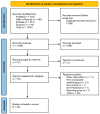The Effect of Gut Microbiota-Targeted Interventions on Neuroinflammation and Motor Function in Parkinson's Disease Animal Models-A Systematic Review
- PMID: 38785512
- PMCID: PMC11120577
- DOI: 10.3390/cimb46050244
The Effect of Gut Microbiota-Targeted Interventions on Neuroinflammation and Motor Function in Parkinson's Disease Animal Models-A Systematic Review
Abstract
Gut microbiome-targeted interventions such as fecal transplant, prebiotics, probiotics, synbiotics, and antibiotic gut depletion are speculated to be of potential use in delaying the onset and progression of Parkinson's disease by rebalancing the gut microbiome in the context of the gut-brain axis. Our study aims to organize recent findings regarding these interventions in Parkinson's disease animal models to identify how they affect neuroinflammation and motor outcomes. A systematic literature search was applied in PubMed, Web of Science, Embase, and SCOPUS for gut microbiome-targeted non-dietary interventions. Studies that investigated gut-targeted interventions by using in vivo murine PD models to follow dopaminergic cell loss, motor tests, and neuroinflammatory markers as outcomes were considered to be eligible. A total of 1335 studies were identified in the databases, out of which 29 were found to be eligible. A narrative systematization of the resulting data was performed, and the effect direction for the outcomes was represented. Quality assessment using the SYRCLE risk of bias tool was also performed. Out of the 29 eligible studies, we found that a significant majority report that the intervention reduced the dopaminergic cell loss (82.76%, 95% CI [64.23%, 94.15%]) produced by the induction of the disease model. Also, most studies reported a reduction in microglial (87.5%, 95% CI [61.65%, 98.45%]) and astrocytic activation (84,62%, 95% CI [54.55%, 98.08%]) caused by the induction of the disease model. These results were also mirrored in the majority (96.4% 95% CI [81.65%, 99.91%]) of the studies reporting an increase in performance in behavioral motor tests. A significant limitation of the study was that insufficient information was found in the studies to assess specific causes of the risk of bias. These results show that non-dietary gut microbiome-targeted interventions can improve neuroinflammatory and motor outcomes in acute Parkinson's disease animal models. Further studies are needed to clarify if these benefits transfer to the long-term pathogenesis of the disease, which is not yet fully understood. The study had no funding source, and the protocol was registered in the PROSPERO database with the ID number CRD42023461495.
Keywords: antibiotics; fecal microbiota transplant; gut–brain axis; inflammation; microbiome; microglial activation; neurodegenerative disorders; prebiotics; probiotics; synbiotics.
Conflict of interest statement
The authors declare no conflicts of interest.
Figures
References
-
- Lampropoulos I.C., Malli F., Sinani O., Gourgoulianis K.I., Xiromerisiou G. Worldwide Trends in Mortality Related to Parkinson’s Disease in the Period of 1994-2019: Analysis of Vital Registration Data from the WHO Mortality Database. Front. Neurol. 2022;13:956440. doi: 10.3389/fneur.2022.956440. - DOI - PMC - PubMed
Publication types
LinkOut - more resources
Full Text Sources



